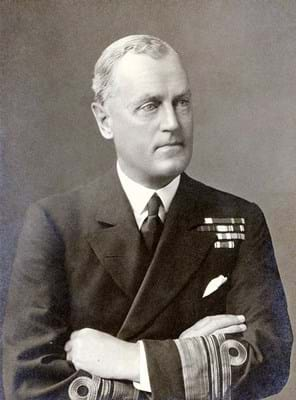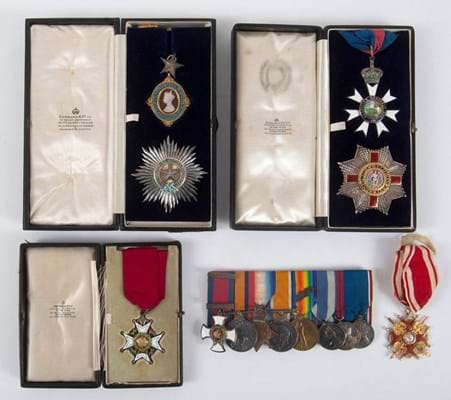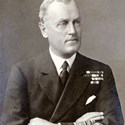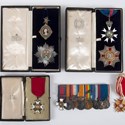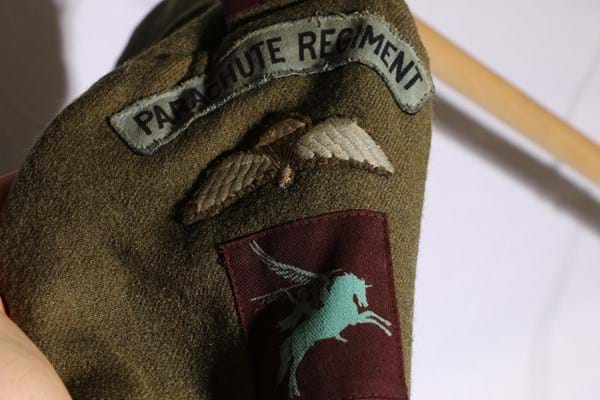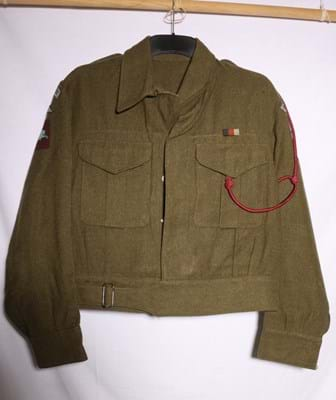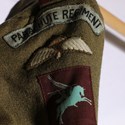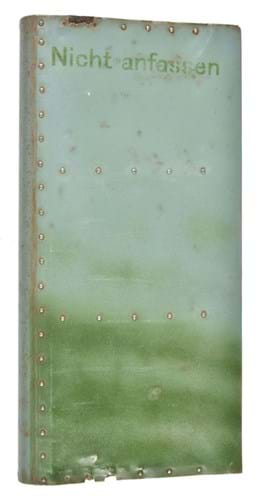
Flying bomb relic at Dominic Winter
A Second World War V1 flying bomb rudder which was recovered in Kent and kept as a ‘souvenir’ by a Home Guard member sold for £3600 (or £4464 including premium) at Gloucestershire saleroom Dominic Winter on May 16.
Estimated at £400-600 in the Aviation, Militaria, Medals and Transport Memorabilia auction in South Cerney, the 20 x 9.5in (50.5 x 24.5cm) relic was of rivetted aluminium construction retaining paint and markings stamped Nicht anfassen (do not touch).
The V1 – aka Doodlebug – first appeared in British skies in June 1944, looking like a small plane but without a pilot. It flew until it ran out of fuel and came down, blowing up. In September the V2 appeared, which was more of a rocket - a long-distance weapon that could travel at the speed of sound.
Nearly 9000 people were killed by Hitler’s ‘vengeance’ weapons. Many areas of south London in particular were badly damaged.
Earlier rockets in auction action at Dix Noonan Webb
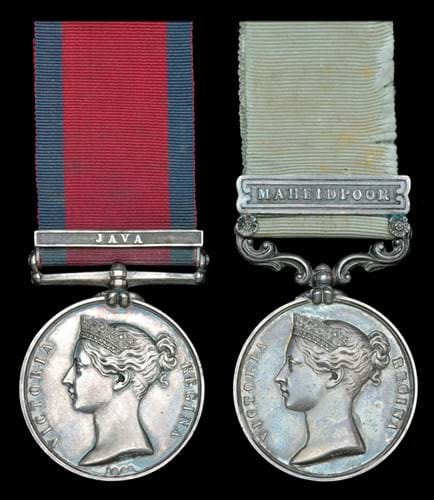
At the Dix Noonan Webb auction on May 8-9 a rare combination of medals, a pair awarded to Major James Harrison, Rocket Troop, Madras Horse Artillery, sold for £12,000.
A much earlier kind of rocket compared to the V1 was involved in a medal group offered by London auction house Dix Noonan Webb on May 8-9. The pair awarded to Major James Harrison, Rocket Troop, Madras Horse Artillery, sold for £12,000 (£14,400 with premium) against an estimate of £3000-3600.
The pair comprised the rare combination of Military General Service 1793-1814, one clasp for Java (which the British invaded in 1811), and Army of India 1799-1826, one clasp for Maheidpoor (a battle during the Third Anglo-Maratha War in 1817). Clasps were added to the medals to note particular battles or actions the recipient had fought in.
Only seven clasps for Java were issued to Honourable East India Company artillery and Harrison was the only Madras officer. Only 13 clasps for Maheidpoor were given to the Madras Artillery, including three officers, Harrison being the only officer of the Rocket Troop to receive this clasp.
The British rockets were developed by William Congreve in 1804 and first used in 1806 but were actually based on those used by the Kingdom of Mysore. The Chinese has employed rockets well before this in medieval times.
The Congreve rocket delivered distinctly mixed results, however. They certainly had one long-lasting effect: those launched by the Royal Navy over Baltimore Harbour during the battle for Fort McHenry in 1814 inspired the words ‘And the rocket’s red glare, the bombs bursting in air, gave proof through the night that our flag was still there’ in The Star-Spangled Banner.
Fantastic Great War photo album at Lockdales
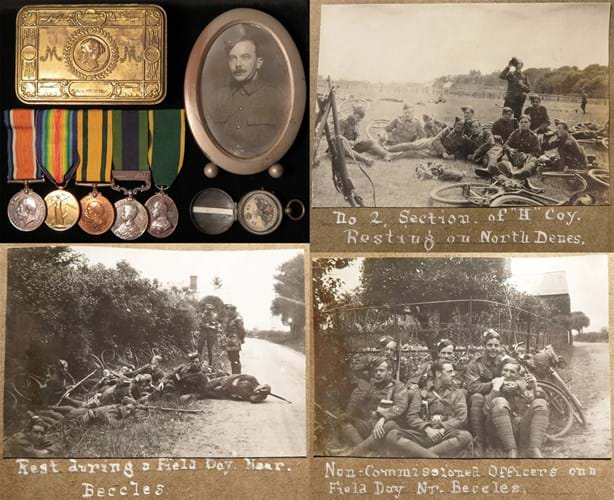
A First World War militaria lot sold for £4200 at Lockdales' auction included a photo album relating to the 25th London Cyclists unit.
What was described by the auction house as “possibly the best original personal photo album we have sold” formed part of a First World War militaria lot estimated at £500-600 which ended up selling for £4200 (£5019 with premium).
The items related to a JF Gerrard, such as Great war medals and anIndia General Service Medal with Afghanistan North-West Frontier 1919 clasp.
Among the huge technological advances in warfare at this time, such as improved machine-guns and artillery, submarines, tanks and aircraft, the role of the simple bicycle is often overlooked. Gerrard was part of the 25th London Cyclists.
The lot included The London Cyclist Battalion book and 25th London (Cyclist) Old Comrades Ass Silver Jubilee Bulletin 1946, but that noteworthy photo album was a big draw with 33 pages of photos and “superb postcards”, covering his time in 1914 with the 25th London Cyclists in and around Suffolk.
Safer and more user-friendly bicycles appeared towards the end of the 19th century and the military began to realise their potential advantages, such as not needing fodder like horses.
Bicycle troops served in the Second Boer War but the first large-scale formalisation of their role was under the Haldane army reforms of 1908 and the creation of 10 bicycle units for the Territorial Force. In November 1914 a specialist army cyclist corps was set up.
The Army Cyclist Corps was founded in 1915 but after the war cyclists were regarded as having little future value and the corps was disbanded in 1919. All remaining territorial battalions had been converted back to conventional infantry by 1922.
Illustrious naval career reflected in Somerset sale
A 12-medal group awarded to Vice Admiral Sir Humphrey Walwyn (1879-1957) whose illustrious career in the navy spanned the Second Boer War, the Great War and the Second World War, sold for a low-estimate £25,000 at Lawrences of Crewkerne on May 16-17.
Walwyn received the Queen’s South Africa medal aboard HMS Beagle. He served on HMS Warspite at the Battle of Jutland in 1916 where she was badly damaged: holed 150 times and 14 killed and 16 wounded.
He was promoted to captain that same year before taking command of HMS Queen Elizabeth and HMS Valiant. By 1928, Walwyn was rear admiral and four years later was promoted to vice admiral.
The group includes the Knight Commander Star of India, the Knight Commander Order of St Michael and St George and the Companion of the Order of the Bath as well as George V Distinguished Service Order and a selection of other notable awards.
Uniform surprise at £1300 in Edinburgh
A simple Second World War Army dress uniform khaki green tunic intrigued an online bidder who bought it for £1300 at the May 23 Thomson Roddick auction in Edinburgh. The estimate was just £20-40.
It featured a ‘made in Australia’ label dated 1943 with Parachute Regiment cloth shoulder title badge, Pegasus flashes, Parachute wings and medal ribbon for the 1939-45 Star.
In 1941-42, a group of airborne officers lead by Lt Gen Frederick ‘Boy’ Browning worked on the formation of British airborne forces.
According to paradata.org.uk: “Gen Browning was acutely aware that the then fledgling airborne forces needed a powerful, unifying symbol. After rejecting a design of lightning flashes as too ‘Germanic’ the myth of Bellerophon astride Pegasus was remembered and the symbol of airborne forces was born as the now well-known flash.
“The design was created by Major Edward Seago and was to be worn on the arm of all airborne soldiers. Seago was a self-taught artist who specialized in landscapes, street scenes and portraits. He was commissioned into the Royal Engineers to help develop camouflage techniques and it was he who was commissioned by Browning to develop the now famous flash.”
The Daphne Du Maurier connection
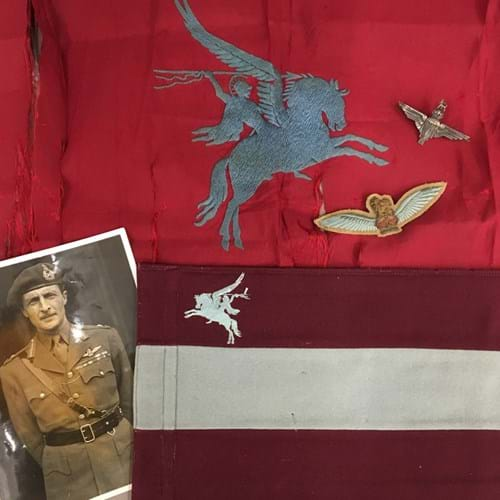
Daphne Du Maurier archive at Rowley’s in Ely on April 27 included several items related to Lt Gen 'Boy' Browning, her husband. The top seller, at a hammer price of £9800, was a lot including this 1st Airborne Division staff car pennant.
Incidentally, the white-glove (the term for a sale where all of the lots sold) auction of the Daphne Du Maurier archive at Rowley’s in Ely on April 27 included several items related to Browning, her husband.
The top seller, at a hammer price of £9800 against an estimate of £100-150, was a lot comprising a 1st Airborne Division staff car pennant depicting Pegasus, a silk flag also depicting Pegasus (in poor condition), two Parachute Regiment badges, one cloth, one metal, and a black and white photographic print of Browning.


